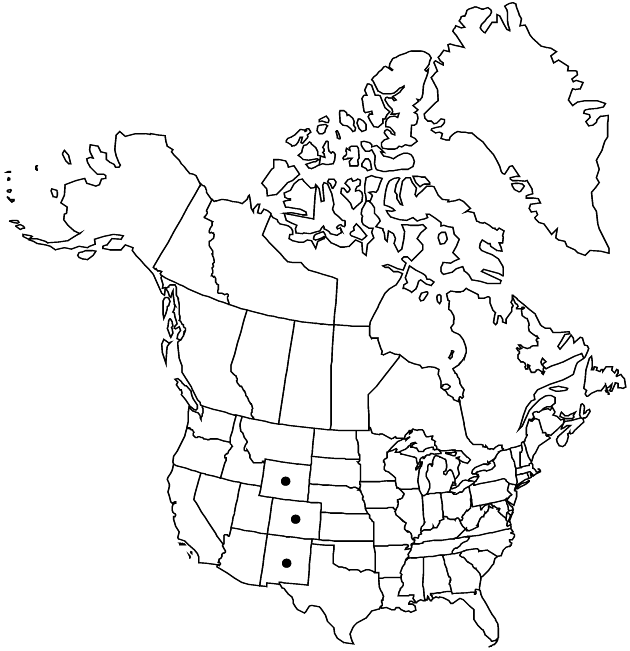Difference between revisions of "Packera fendleri"
Phytologia 49: 46. 1981.
FNA>Volume Importer |
imported>Volume Importer |
||
| (5 intermediate revisions by 2 users not shown) | |||
| Line 8: | Line 8: | ||
}} | }} | ||
|common_names=Fendler’s ragwort | |common_names=Fendler’s ragwort | ||
| − | |basionyms={{Treatment/ID/ | + | |special_status={{Treatment/ID/Special_status |
| + | |code=E | ||
| + | |label=Endemic | ||
| + | }} | ||
| + | |basionyms={{Treatment/ID/Basionym | ||
|name=Senecio fendleri | |name=Senecio fendleri | ||
|authority=A. Gray | |authority=A. Gray | ||
| + | |rank=species | ||
| + | |publication_title=Mem. Amer. Acad. Arts, n. s. | ||
| + | |publication_place=4: 108. 1849 | ||
}} | }} | ||
|synonyms={{Treatment/ID/Synonym | |synonyms={{Treatment/ID/Synonym | ||
|name=Senecio canovirens | |name=Senecio canovirens | ||
|authority=Rydberg | |authority=Rydberg | ||
| + | |rank=species | ||
}} {{Treatment/ID/Synonym | }} {{Treatment/ID/Synonym | ||
|name=Senecio fendleri var. molestus | |name=Senecio fendleri var. molestus | ||
|authority=Greenman | |authority=Greenman | ||
| + | |rank=variety | ||
}} {{Treatment/ID/Synonym | }} {{Treatment/ID/Synonym | ||
|name=Senecio nelsonii | |name=Senecio nelsonii | ||
|authority=Rydberg | |authority=Rydberg | ||
| + | |rank=species | ||
}} {{Treatment/ID/Synonym | }} {{Treatment/ID/Synonym | ||
|name=Senecio rosulatus | |name=Senecio rosulatus | ||
|authority=Rydberg | |authority=Rydberg | ||
| + | |rank=species | ||
}} {{Treatment/ID/Synonym | }} {{Treatment/ID/Synonym | ||
|name=Senecio salicinus | |name=Senecio salicinus | ||
| − | |authority= | + | |authority= |
| + | |rank=species | ||
}} | }} | ||
|hierarchy=Asteraceae;Asteraceae tribe Senecioneae;Packera;Packera fendleri | |hierarchy=Asteraceae;Asteraceae tribe Senecioneae;Packera;Packera fendleri | ||
| Line 51: | Line 63: | ||
-->{{#Taxon: | -->{{#Taxon: | ||
name=Packera fendleri | name=Packera fendleri | ||
| − | |||
|authority=(A. Gray) W. A. Weber & Á. Löve | |authority=(A. Gray) W. A. Weber & Á. Löve | ||
|rank=species | |rank=species | ||
| Line 65: | Line 76: | ||
|publication title=Phytologia | |publication title=Phytologia | ||
|publication year=1981 | |publication year=1981 | ||
| − | |special status= | + | |special status=Endemic |
| − | |source xml=https:// | + | |source xml=https://bitbucket.org/aafc-mbb/fna-data-curation/src/2e0870ddd59836b60bcf96646a41e87ea5a5943a/coarse_grained_fna_xml/V19-20-21/V20_1307.xml |
|tribe=Asteraceae tribe Senecioneae | |tribe=Asteraceae tribe Senecioneae | ||
|genus=Packera | |genus=Packera | ||
Latest revision as of 19:59, 5 November 2020
Perennials, 10–40+ cm; rhizomatous (rhizomes horizontal to suberect, branched). Stems 1 or multiple (crowded to subcespitose), floccose-tomentose or glabrescent. Basal leaves petiolate; blades lanceolate to oblanceolate, 30–60+ × 10–30+ mm, bases tapering, margins shallowly, evenly pinnatifid to pinnatisect or wavy (adaxial faces floccose-tomentose or subglabrescent). Cauline leaves gradually reduced (sessile; lanceolate to oblanceolate, pinnatisect to wavy). Heads 6–25+ in open or compact, corymbiform arrays. Peduncles bracteate, densely to irregularly floccose. Calyculi 0 or inconspicuous (bractlets red-tinged). Phyllaries 13, green, 5–7 mm, floccose proximally to glabrescent distally. Ray florets 6–8+; corolla laminae 5–7 mm. Disc florets 30–40+; corolla tubes 2.5–3 mm, limbs, 2.5–3.5 mm. Cypselae 2.5–3 mm, glabrous; pappi 4–5 mm. 2n = 46.
Phenology: Flowering late May–early Oct.
Habitat: Steep slopes, loose, dry rocky or gravelly soils, along streams, open forests, disturbed sites
Elevation: 1600–3200 m
Distribution

Colo., N.Mex., Wyo.
Discussion
Packera fendleri is abundant, almost weedy in the southern Rocky Mountains. It thrives in a wide range of elevations and in a wide variety of habitats; flowering times vary. It frequently grows in close association with other species of Packera and may hybridize with them.
Selected References
None.